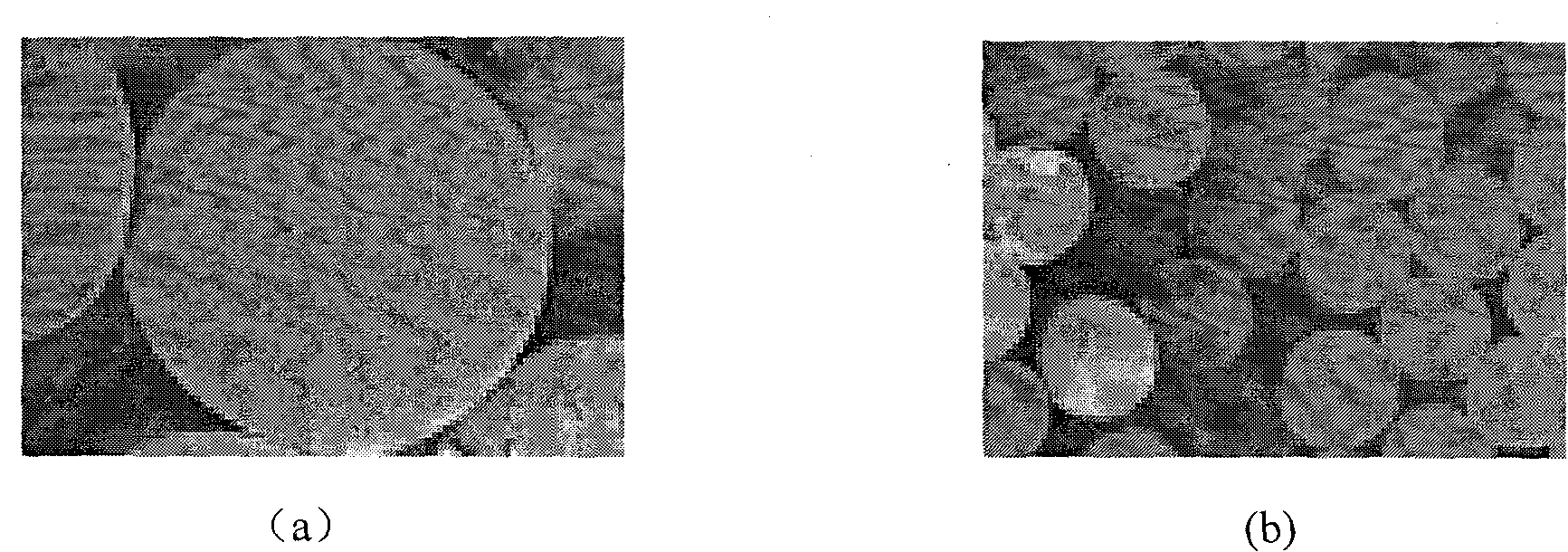Preparation method for meta-aromatic polyamide fiber
An aromatic polyamide and fiber technology, which is applied in the field of preparation of meta-aramid fibers, can solve problems such as affecting the mechanical properties of finished fibers, increasing fiber voids, and large fiber micropores.
- Summary
- Abstract
- Description
- Claims
- Application Information
AI Technical Summary
Problems solved by technology
Method used
Image
Examples
Embodiment 1
[0027] Dissolve 1 part by weight of refined m-phenylenediamine (MPD) in 8.7 parts by weight of freshly distilled dry DMAc, and add 1.7 parts by weight of refined isophthaloyl chloride (IPC) at -10°C The precondensation is carried out to form a prepolymer containing hydrogen chloride, and the remaining 0.18 parts by weight of IPC are polymerized, and the temperature of the reactor is controlled below 50° C. for 1 hour to obtain a colorless and transparent polymer. Next, neutralize, neutralize the Ca(OH) used 2 The parts by weight are 0.685. Finally obtain polymer-containing 18.1wt%, logarithmic reduced viscosity η inh 1.86, CaCl 2 A spinning dope with a content of 8.26 wt%. For defoaming, control the temperature at 60°C and the spinning dope is metered by a metering pump under a nitrogen pressure of 0.2-0.5 MPa, and then extruded through a spinneret with 300 holes with a diameter of 0.08 mm into a first-stage coagulation bath. The coagulation bath composition is H 2 O 40wt...
Embodiment 2
[0029] Dissolve 1 part by weight of refined m-phenylenediamine (MPD) in 8.7 parts by weight of freshly distilled dry NMP, and add 1.7 parts by weight of refined isophthaloyl chloride (IPC) at -10°C The precondensation is carried out to form a prepolymer containing hydrogen chloride, and the remaining 0.18 parts by weight of IPC are polymerized, and the temperature of the reactor is controlled below 50° C. for 1 hour to obtain a colorless and transparent polymer. Next, neutralize, neutralize the Ca(OH) used 2 The parts by weight are 0.685. Finally, the polymer containing 18.1%, the logarithmic reduced viscosity η inh 1.86, CaCl 2 A spinning dope with a content of 8.26%. For defoaming, control the temperature at 60°C and the spinning dope is metered by a metering pump under a nitrogen pressure of 0.2-0.5 MPa, and then extruded through a spinneret with 300 holes with a diameter of 0.08 mm into a first-stage coagulation bath. The coagulation bath composition is H 2 O20wt%, NM...
Embodiment 3
[0031]Dissolve 1 part by weight of refined m-phenylenediamine (MPD) in 10 parts by weight of freshly distilled dry DMAc, and add 1.7 parts by weight of refined isophthaloyl chloride (IPC) at -10°C Pre-condensation is carried out to form a prepolymer containing hydrogen chloride, and the remaining 0.18 parts by weight of IPC is polymerized, and the temperature of the reactor is controlled below 50° C. for 1 hour to obtain a colorless and transparent polymer. Next, neutralize, neutralize the Ca(OH) used 2 The parts by weight are 0.685. Finally, a polymer containing 15.8 is obtained, and the logarithmic reduced viscosity η inh 1.71, CaCl 2 Spinning dope with a content of 7.21. For defoaming, control the temperature at 60°C and the spinning dope is metered by a metering pump under a nitrogen pressure of 0.2-0.5 MPa, and then extruded through a spinneret with 300 holes with a diameter of 0.08 mm into a first-stage coagulation bath. The coagulation bath composition is H 2 O 30w...
PUM
| Property | Measurement | Unit |
|---|---|---|
| elongation at break | aaaaa | aaaaa |
| elongation at break | aaaaa | aaaaa |
Abstract
Description
Claims
Application Information
 Login to View More
Login to View More - R&D
- Intellectual Property
- Life Sciences
- Materials
- Tech Scout
- Unparalleled Data Quality
- Higher Quality Content
- 60% Fewer Hallucinations
Browse by: Latest US Patents, China's latest patents, Technical Efficacy Thesaurus, Application Domain, Technology Topic, Popular Technical Reports.
© 2025 PatSnap. All rights reserved.Legal|Privacy policy|Modern Slavery Act Transparency Statement|Sitemap|About US| Contact US: help@patsnap.com



